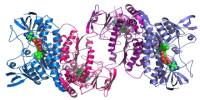The gelada-the “bleeding heart” monkey named for its beautiful red chest lives among the high mountain meadows and grasslands of Ethiopia’s plateau. Geladas are the last of their kind, having outlived their extinct ancestors by leading an unconventional lifestyle. Geladas, unlike their forest and savannah-dwelling monkey kin, have carved out a high-altitude niche for themselves, subsisting on highland grasses.
Geladas are generally found in herds, clinging to cliffs in the morning and resting on their cushion-like rumps that are suitable for sitting and grazing all day, in addition to their competent mountaineering skills.
What distinguishes them from their baboon counterparts in their ability to thrive in the thin airs of the plateau, 6,000-14,000 feet above sea level? And could these features have implications for human adaptation?
“Life at high altitude is very difficult. The air is colder and contains less oxygen,” said Snyder-Mackler. “Our team has studied geladas living in such extreme environments for over a decade, so we have a firsthand understanding of how challenging it can be to live at such heights over extended periods of time. Yet geladas have survived for much longer, making us wonder how exactly they have shifted their biology to adapt to their challenging environments.”
ASU School of Life Sciences professor Noah Snyder-Mackler and postdoctoral researcher Kenneth Chiou led a team to first assemble and sequence the gelada genome in order to decipher the genetic clues underpinning high-altitude adaption.
“We were interested in studying gelada high-altitude adaptations because, unlike any human population, geladas have continuously lived at high altitudes for hundreds of thousands of years, giving us a window into how primates cope with extreme environments over deep time.”
“As geladas are closely related to us and share much of our biology, our hope is that learning more about geladas may lend insights into treatments for diseases and disorders associated with high altitude, including mountain sickness and dangerous swelling of the brain and lungs,” said Kenneth Chiou, who combed the continent with colleagues to coordinate access to wild geladas and helped lead the study.
The absence of an elevated hemoglobin concentration in wild geladas living at high altitude suggests that they can still provide enough oxygen to tissues in spite of the reduced availability of oxygen. There are a lot of other ways geladas could be physiologically compensating for low oxygen and these could entail many kinds of changes to respiratory or circulatory traits that affect oxygen transport.
Kenneth Chiou
They coupled a rigorous assessment of data acquired from wild geladas with the first gelada reference genome, which was constructed from a single wild adult female gelada from the Simien Mountains in Ethiopia, to find any adaptations to their high-altitude environment.
Into thin air
The most apparent place to start inside the gelada genome was with hemoglobins proteins that unite in a group of four, like a mythical four-leafed clover, to form the essential oxygen-carrying molecule present in the blood.
“Many animals that have adapted to high altitude have evolved hemoglobin that can more efficiently bind oxygen, which can increase the efficiency of oxygen delivery in the bloodstream when faced with low-oxygen environments,” said Snyder-Mackler.
They discovered gelada-specific amino acid changes in adult hemoglobin’s alpha-chain subunit first. They believed they had discovered their high-altitude adaption chemical signature. They discovered two amino acid changes in hemoglobin alpha that are unique to geladas when compared to other primates, at positions 12 and 23.
Most interestingly, these substitutions were discovered in all 70 geladas sequenced in the study, along with all coding sequences for this protein.
When they evaluated these alterations in the lab, however, they were taken aback. Surprisingly, they discovered no variations in gelada hemoglobin P50 (a measurement of the partial pressure at which hemoglobin is 50% saturated) between humans and baboons.
“When we found unique changes in the molecular sequence of gelada hemoglobin, we thought it was a slam dunk that these molecular changes would be the key to their ability to thrive at high altitude,” said Snyder-Mackler, “But our experiments showed that this is not the case, and provide a good reminder of the importance of experimental validation of compelling hypotheses.”
The amino acid alterations discovered in gelada hemoglobin did not appear to be connected with improved hemoglobin-oxygen affinity on a molecular level. As a result, Snyder-Mackler and Chiou turned their attention to another possible adaptive strategy.
When we reach a high altitude, our bodies detect a decrease in oxygen and respond by generating more oxygen-carrying hemoglobin and red blood cells. If geladas had higher hemoglobin levels in their blood, the theory goes, they could be able to improve oxygen delivery in the blood without requiring better oxygen-binding hemoglobin.
Instead, they discovered that the quantities of hemoglobin in gelada blood were no different from those seen in people, baboons, or even geladas in zoos at sea level.
“The absence of an elevated hemoglobin concentration in wild geladas living at high altitude suggests that they can still provide enough oxygen to tissues in spite of the reduced availability of oxygen,” said Chiou. “There are a lot of other ways geladas could be physiologically compensating for low oxygen and these could entail many kinds of changes to respiratory or circulatory traits that affect oxygen transport.”
So, the team was forced to look elsewhere within the genome for high-altitude adaptations.
After that, they looked at a physiological test to see if the adaptation was due to geladas having evolved a larger lung capacity. Indeed, high-altitude geladas had dramatically larger chest circumferences, presumably allowing for more lung surface area for improved oxygen transport, according to their findings.
“Our results show that geladas have significantly expanded relative chest circumferences compared to baboons, which parallels the larger chest dimensions exhibited by native Andean highlanders,” said Chiou.
“This finding is consistent with the possibility of expanded lung volumes, but we want to be careful because we did not directly measure lungs in this study. We also do not yet know whether these differences are developmental responses to low-oxygen environments or due to a genetically controlled component of the adaptive toolkit in geladas.”
Finally, a comparison to chest measurements of captive geladas born and raised at low altitudes, which are currently unavailable, would aid in distinguishing between these two alternatives.
To higher ground
With the hemoglobin protein picture ruled out and the lung capacity puzzle still unexplained, they turned to genetic differences for any additional evidence. They cast a wide net across the gelada genome’s roughly 20,000 protein-coding genes.
They found 103 genes with positive selection signals in geladas that may have evolved in response to the high-altitude environment.
These included four genes involved in a hypoxia pathway (ITGA2, NOTCH4, FERMT1, and MLPH). They also identified several that have been identified as candidate genes in human hypoxia-adapted populations, including FRAS1 (which is involved in renal agenesis and exhibits adaptation signatures in Tibetans and Ethiopians).
HMBS, a gene implicated in heme production in Nepalese Sherpas, and TNRC18, a mostly unknown gene connected to a selection in Bajau deep-sea divers, were also discovered.
“While we found a lot of overlap between pathways under selection in geladas and human populations living at high altitudes, aside from notable examples listed above, few genes identified by our analysis were shared with candidate genes reported by studies of high-altitude human populations or other high-altitude primates,” said Chiou.
“This suggests that gelada adaptations to similar challenges at high altitude may largely involve adaptations in different suites of genes. In other words: natural selection may have found a different molecular solution to the same problem.”
They will have to continue their gene investigations to deepen their understanding now that the basis has been laid.
Conservation implications
When a new genome for an animal is completed, it creates a completely new picture of how the population came to be, as well as new insights into its genetic variety.
The team also sequenced the whole genomes of 70 captive and wild geladas from various parts of Ethiopia (3 wild central geladas; 50 wild northern geladas; 17 captive geladas of central origin) as well as 20 hamadryas baboons from Filoha, Ethiopia, to better understand the demographic history of geladas, including historical population sizes and population divergence.
The geladas in their sample set were divided into two subspecies: the northern population, which includes all wild individuals from the Simien Mountains, and the central population, which includes wild individuals from the Guassa Community Conservation Area as well as the majority of zoo animals.
“We found no evidence of interbreeding between the two wild gelada populations, and the genetic data suggest that these two populations have been separated from each other for around 500 thousand years,” said Chiou.
They also discovered a strange and substantial change in gelada chromosomes, or karyotype, that appears to be quite common and possibly fixed in the northern population of geladas, a chromosomal split. They believe that the chromosomal divide occurred in northern geladas after this group separated around half a million years ago.
The research team believes that this will be an important piece of information for conservation efforts in the future and that it may cause confusion in the existing taxonomy of gelada species.
“Given that chromosomal rearrangements tend to be associated with infertility-like mules, which are the hybrid offspring of a horse and a donkey, our findings suggest that geladas may encompass at least two distinct biological species,” said Chiou.
Chiou says this finding is important for a couple of reasons.
“First, a taxonomic revision would roughly halve the populations of each gelada species and, consequently, add urgency to conservation efforts to preserve this previously unappreciated diversity,” said Chiou.
“Second, the split chromosome we discovered in northern geladas appears to be an extraordinarily recent example of a stable chromosomal variant in a long-lived primate. It therefore provides a unique opportunity to study chromosome evolution and the role of chromosomal rearrangements in speciation in a primate closely related to humans.”
Next steps
The team intends to improve their understanding of gelada high-altitude adaptation as a result of the study’s findings. They now have a plethora of new and promising research avenues to pursue.
“From this study, we identified a suite of gelada-specific traits that may confer adaptation to their high-altitude environment, including evidence for increased lung capacity and positive selection in a number of hypoxia-related genes and regulatory regions,” said Snyder-Mackler.
“With this in mind, our genome assembly and gelada-specific genetic changes provide multiple avenues for future research on the function of the protein-coding and regulatory changes unique to geladas. This research builds on our current understanding of the mechanisms of adaptation to extreme environments and provides an avenue for research that may have a transformative impact on the study and treatment of hypoxia-related conditions.”
The work was made possible by a large international effort from more than 30 institutions, and with the generous permissions and support from the African Wildlife Foundation, Ethiopian Wildlife Conservation Authority, the National Science Foundation, National Institutes of Health the San Diego Zoo, University of Washington Royalty Research Fund and the German Research Foundation.
Snyder-Mackler and Chiou are particularly thankful for the research staff who made the research possible (E. Jejaw, A. Fenta, S. Girmay, D. Bewket and A. Adwana), logistical support staff (T. W. Aregay and S. Asrat) and assistants and students of the Simien Mountains Gelada Research Project especially J. Jarvey and M. Gomery as well as the EWCA for permission and support for working in the Simien Mountains National Park.
















